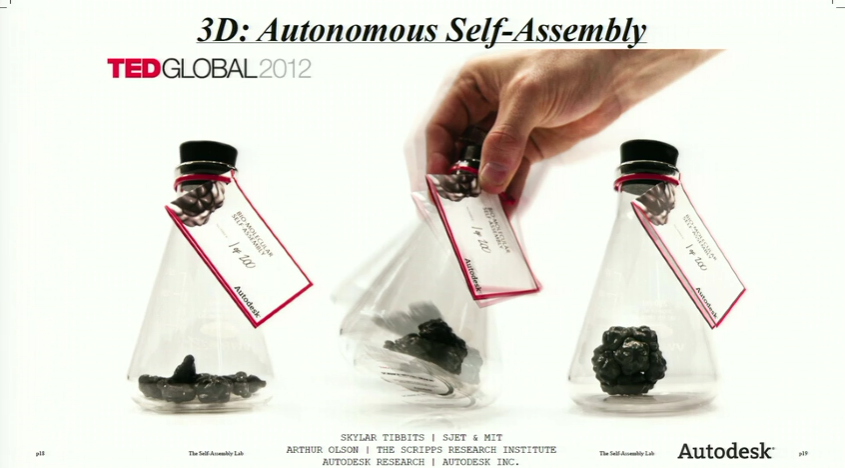In three dimensions, we did a project last year at TED Global with Autodesk and Arthur Olson where we looked at autonomous parts -- so individual parts not pre-connected that can come together on their own.
对于三维系统,我们去年在TEDGlobal和Autodesk(欧特克)以及Arthur Olson做了一个项目,我们研究了分散独立的零件——就是怎样让各自分散的部分自发的组合在一起。
And we built 500 of these glass beakers.
我们一共做了500个这样的烧杯。
They had different molecular structures inside and different colors that could be mixed and matched.
里面有不同的分子结构以及不同的可以相互混杂搭配的颜色。
And we gave them away to all the TEDsters.
我们把它们给了所有在场的TED观众。
And so these became intuitive models to understand how molecular self-assembly works at the human scale.
这些形象的模型帮助我们在宏观上理解分子是如何自我组装的。
This is the polio virus. You shake it hard and it breaks apart.
这个是脊髓灰质炎病毒。你使劲儿一摇,它就散架了。

And then you shake it randomly and it starts to error correct and built the structure on its own.
然后你随便摇瓶子,它就开始纠错然后自己组合成本来的结构形状。
And this is demonstrating that through random energy, we can build non-random shapes.
这个例子说明了我们可以利用不规则的运动能量形成规则的物体形状。
We even demonstrated that we can do this at a much larger scale.
我们甚至证明了它同样适用于更加宏观的层面。
Last year at TED Long Beach, we built an installation that builds installations.
去年在TED的 Long Beach,我们做了一个可以制造其它设备的装置。
The idea was, could we self-assemble furniture-scale objects?
想法就是我们能不能自我组装家具大小的物体呢?
So we built a large rotating chamber, and people would come up and spin the chamber faster or slower, adding energy to the system
所以我们做了一个大的滚动的空间,然后人们过来或快或慢的滚动它来给这个系统增加能量,
and getting an intuitive understanding of how self-assembly works
从而更形象的理解了自我组装是怎么一回事,
and how we could use this as a macroscale construction or manufacturing technique for products.
以及我们怎样在产品的宏观建设或制造技术上利用它。












